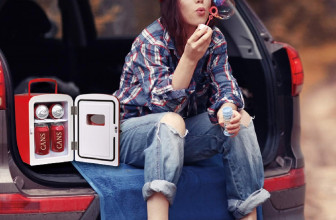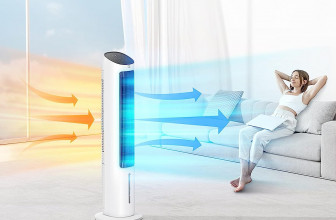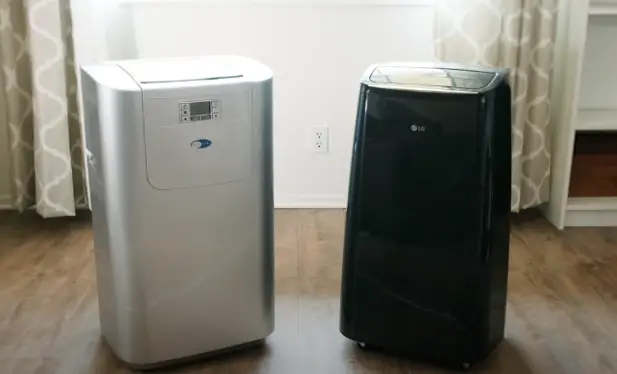
Year after year, two air conditioner brands keep coming out on top in these tests.
CollegeDormEssentials.com is a participant in the Amazon Services LLC Associates Program, an affiliate advertising program designed to provide a means for sites to earn advertising fees by advertising and linking to Amazon.com
The Best Portable AC
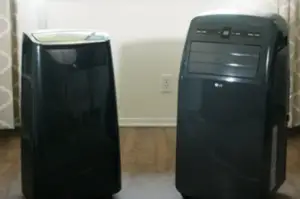 LG PORTABLES 12,000 BTU
LG PORTABLES 12,000 BTU
Each brand is better for different reasons, though. We like the LG portables for refined design, quiet fans and top-ranked performance in most conditions. This new 12,000 BTU model is a fresh update of the model we’ve had for three summers, and it’s even better than our old favorite. However, if you’re in a climate where temperatures soar above 95 every week during the summer, the LG’s single-hose design just isn’t effective.

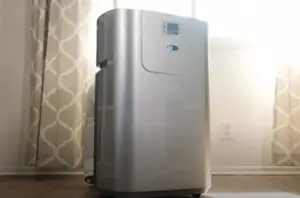 WHYNTER ARC-122DS
WHYNTER ARC-122DS
Instead, you’ll want to choose the Arc-122DS from Whynter. This one uses a dual-hose design that can actually cool a room during a heat wave, and it’s also a well-built, quiet performer. If you want to find out more about how portable air conditioners work, keep reading for all the details on the new performance standards.
Dehumidifier, Fan with Activated Carbon Filter plus Storage bag for Rooms up to 400 sq ft
ADVANTAGES AND DISADVANTAGES OF A PORTABLE AIR CONDITIONER
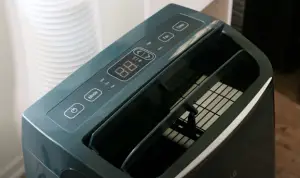 Why a portable air conditioner?
Why a portable air conditioner?
If you compare a portable air conditioner with a window, wall mount or central air conditioner system, there are a few advantages and a few big drawbacks.
The first advantage is, you can install a portable just about anywhere. If you’ve got the wrong kind of window for a window unit, this is the easiest way to get relief from the heat.
Second, you can move a portable AC from one room to another. It takes some time to seal the window, and we don’t think anyone’s gonna want to carry one of these up and down a flight of stairs every day, but it’s much easier than moving a window unit.
The drawbacks are pretty serious, though. Our favorite two portable ACs will still blow cold air when the outside temperature soar, but even at only 75% of the rated size, our window AC unit quickly cooled the room to a much lower temperature than the portables could.
The other downside is noise. Fan noise is going to be an annoyance when you’re running any air conditioner, but with a portable, all the noisy components like the compressor are also right there in the room beside you.
SINGLE-HOSE VS DUAL-HOSE
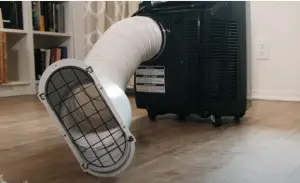 If you do decide you want the flexibility of a portable system, which type should you choose? The answer simply comes down to where you live. At our headquarters in Los Angeles, it only gets above 90 degrees a few days out of every year, at our new office in Dallas, it’s that hot for 114 days most years. If you’re mostly running your AC when temperatures outside are below 90 degrees, a single hose portable does a good job. In fact, if you have heat coming from inside your room, let’s say from an oven, the single hose design is ideal. Single hose types are also far more common, which makes this type easier to find and a bit cheaper to buy. A single hose system has to use air from your house to cool off its components, though. This gives it a bit of a boost when you first turn it on, but overtime air gets sucked in through doors and windows to replace the air that goes out the window through that hose. So when temperatures outside are above 90, all of the air that’s coming into your house is so hot, the single hose AC can’t keep up anymore. The dual hose models, on the other hand, use their second hose to take in air specifically for carrying away heat. They don’t use up air you’ve already cooled, and they minimize extra hot air coming in through all your doors and windows.
If you do decide you want the flexibility of a portable system, which type should you choose? The answer simply comes down to where you live. At our headquarters in Los Angeles, it only gets above 90 degrees a few days out of every year, at our new office in Dallas, it’s that hot for 114 days most years. If you’re mostly running your AC when temperatures outside are below 90 degrees, a single hose portable does a good job. In fact, if you have heat coming from inside your room, let’s say from an oven, the single hose design is ideal. Single hose types are also far more common, which makes this type easier to find and a bit cheaper to buy. A single hose system has to use air from your house to cool off its components, though. This gives it a bit of a boost when you first turn it on, but overtime air gets sucked in through doors and windows to replace the air that goes out the window through that hose. So when temperatures outside are above 90, all of the air that’s coming into your house is so hot, the single hose AC can’t keep up anymore. The dual hose models, on the other hand, use their second hose to take in air specifically for carrying away heat. They don’t use up air you’ve already cooled, and they minimize extra hot air coming in through all your doors and windows.
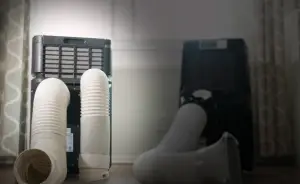 In a moderately hot climate like South California, we didn’t see the full benefit from the dual hose models most of the year and our top single hose models actually performed a little bit better. When the temperatures hit 102 degrees in July, though, the difference was clear. A dual hose portable still isn’t going to cool your room all the way down to 70 in a heat wave, but it isn’t literally heating up your house the way a single hose model does.
In a moderately hot climate like South California, we didn’t see the full benefit from the dual hose models most of the year and our top single hose models actually performed a little bit better. When the temperatures hit 102 degrees in July, though, the difference was clear. A dual hose portable still isn’t going to cool your room all the way down to 70 in a heat wave, but it isn’t literally heating up your house the way a single hose model does.

BTU
So, what’s a BTU? Portable air conditioners also come in a bunch of different sizes, mostly labeled as 10, 12 and 14 thousand BTUs. But what does that mean? The British thermal unit represents a specific amount of heat, and air conditioners are sized by how many BTUs they can take out of your room in an hour as they cool off the air.

For most air conditioners, we always recommend checking the size of your room on a BTU calculator, to see how much heat your AC will need to move out of the room. If it cools too fast, oversized AC makes things clammy. Things get tricky with portables, though. In our testing, we found that even a portable air conditioner that’s supposed to be too big for a room won’t be able to super-cool the space like a bigger window unit could. Portable air conditioners have always performed much more poorly in real world conditions than when they’re in a lab moving heat from one space to another.
 After years of complaints from consumer groups, the Department of Energy regulations on testing changed in 2017. So, what does the new rating show? Most portables perform about 25% worse under the new test. The new testing shows that having the entire AC system inside your room and leaking heat out to the vent hoses makes portables much worse than other AC types. The new labels are sometimes tricky to spot but they’re required on all new portable ACs and they’re all pretty sad.
After years of complaints from consumer groups, the Department of Energy regulations on testing changed in 2017. So, what does the new rating show? Most portables perform about 25% worse under the new test. The new testing shows that having the entire AC system inside your room and leaking heat out to the vent hoses makes portables much worse than other AC types. The new labels are sometimes tricky to spot but they’re required on all new portable ACs and they’re all pretty sad.
TESTING
When we first tested a lineup of portable air conditioners back in 2016, we did extensive research and looked at 20 different air conditioners. We bought the four best models and gave them a summer long workout. We’re still satisfied with the performance of our picks from back then, but most of the models we tested have been replaced by new designs.
We tested two different updates to our old winner, and used this update to test even more models from the goldilocks 12,000 BTU size. We looked at specification sheets, talked to sales reps and dug into reviews to find top performance, great efficiency, quiet operation, and good design.
We bought two current models that were released in 2017, and two brand new designs that were just released for the summer of 2018. How did we test? In 2016, we tested four top ranked units for over 100 hours across two summers in Los Angeles. We took readings of how much the temperature dropped per minute and averaged all the numbers to get performance scores.
For the update test, we’ve set up a bedroom with some carefully planned controls. To get all of our conditions as consistent as possible, we tested when outdoor weather was mild in spring and added heat inside the room with our favorite space heaters, bringing the room up past 89 degrees with the apartment’s central heat and then letting things level off at 85 before beginning each test cycle.
In these torture test conditions, with space heaters constantly adding heat from inside the room, the single hose models from LG outperformed everything else. A poor result from the dual hose system surprised us, so we checked again with a different type of test.
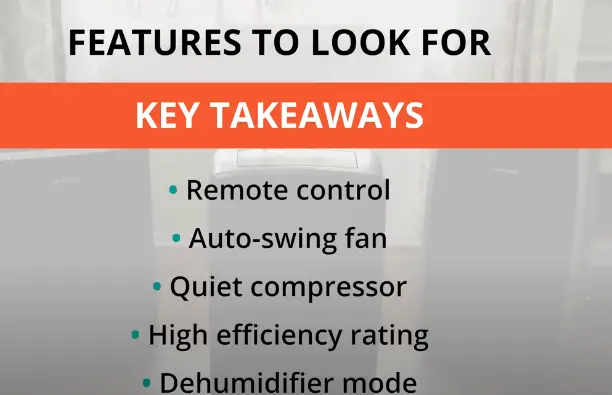
For second round of testing, we set up again in July with back to back days of 100 plus degree weather. We didn’t have any control over the conditions for this test, so the weather was slightly hotter on the day we ran the dual hose model, but it still beat the single hose type easily. We spent 20 hours logging temperature changes and four months using these machines to stay cool. It’s now clear to us that the dual hose and single hose systems make sense in different conditions.
What about noise testing? We tested the compressor starting noise and ongoing fan noise to see which of these machines is least likely to wake you up in the middle of the night. Fortunately, the top picks in both single and dual hose design are also the quietest we’ve tested.
So, what did we find out? The best single hose design was the LG-LP-GRX1218. This machine was really our favorite of the bunch. The controls are good, there are handy features like a magnetic remote storage cubby and a spool for the cord, and it’s tied for the quietest model we’ve tested.
 This is a new model to replace our old favorite from 2016 and that one has worked well for us over three summers of testing. The little touches that are all over LGs air conditioners really add up. The fact that LG includes a sleep mode that actually turns off the lights is one of those little things that tell you a manufacturer cares about design. It is also the best performing air conditioner in our space heater torture test, which makes it an easy pick as well.
This is a new model to replace our old favorite from 2016 and that one has worked well for us over three summers of testing. The little touches that are all over LGs air conditioners really add up. The fact that LG includes a sleep mode that actually turns off the lights is one of those little things that tell you a manufacturer cares about design. It is also the best performing air conditioner in our space heater torture test, which makes it an easy pick as well.
As good as LG’s product design is, though, a single hose design like this will start heating up your room on the hottest days instead of cooling it down. The LG always blows cold air out the front, but the amount of air that’s pulled in through your doors and windows means there’s no way for this machine to really keep your room cool once outside temperatures get past 95.
If you live in a part of the country where it rarely gets above 90, though, this design still works well. LG has been improving this model every few years and we think the new one is the best design of the bunch.
The best portable air conditioner for heat waves is the Whynter ARC 122DS Elite. Whynter specializes in dual hose portables, and this is their most popular model. The Whynter’s performance really stands out once outside temperatures hit 90 degrees.
In our first tests with a space heater for a control, Whynter’s dual-hose system couldn’t keep up and actually made the room hotter after twenty minutes that it was at the start. As we turned off the space heaters for the last part of the test, Whynter’s system never really caught up with the single-hose designs, even after running for an hour with all the space heaters turned off because the difference was so dramatic, we knew this kind of performance couldn’t represent what Wynter’s best selling portable AC was designed to do.
For a second round of tests, we use less controlled, but more realistic conditions during a July heat wave and the Whynter easily beat the single-hose designs. If you’re only suffering through 87 degree summer days there are no major details to set these apart other than the LG’s design being a bit more attractive than the Whynter. Fortunately, this model is basically just as quiet as the LG, so they’re both equally discreet in the bedroom.
The other 12,000 BTU models we tested are all reasonable performers, but the new LG still comes out on top for best overall cooling performance, lowest noise, and best features.
CONCLUSION

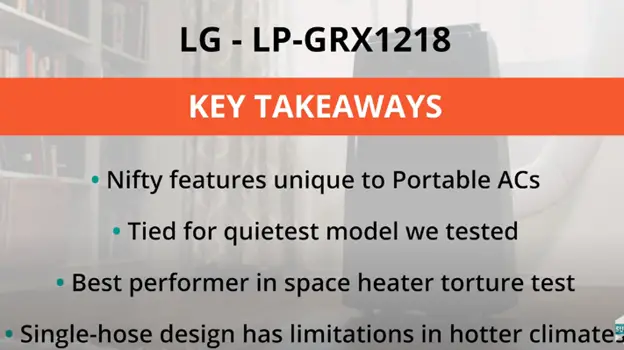
Overall, we’re happy with the performance and flexibility of the new LG 12,000 BTU model. It’s a great design, just like the model it replaces. For regions where the afternoon weather gets up into the 90s or 100s, though, this type of AC just doesn’t work well.
If you’re living in a hot spot like Phoenix, where you already see 90 degrees in March, the Whynter dual-hose design is going to work far better than the LG single-hose.
We hope we’ve helped you find the portable air conditioner that’s right for you.
LG PORTABLES 12,000 BTU
WHYNTER ARC-122DS
Dehumidifier, Fan with Activated Carbon Filter plus Storage bag for Rooms up to 400 sq ft



